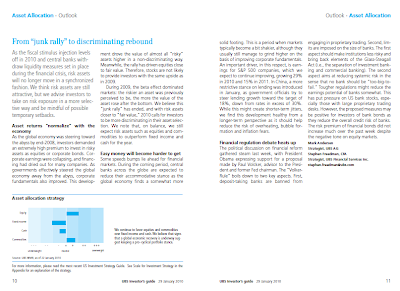
Asset returns “normalize” with the economy
As the global economy was steering toward the abyss by end-2008, investors demanded
an extremely high premium to invest in risky assets as equities or corporate bonds. Corporate
earnings were collapsing, and financing had dried out for many companies. As
governments effectively steered the global economy away from the abyss, corporate
fundamentals also improved. This development drove the value of almost all “risky”
assets higher in a non-discriminating way. Meanwhile, the rally has driven equities close
to fair value. Therefore, stocks are not likely to provide investors with the same upside as
in 2009.
During 2009, the beta effect dominated markets: the riskier an asset was previously
perceived to be, the more the value of the asset rose after the bottom. We believe this
“junk rally” has ended, and with risk assets closer to “fair value,” 2010 calls for investors
to be more discriminating in their asset selection. We note that, on balance, we still
expect risk assets such as equities and commodities to outperform fixed income and
cash for the year.
Easy money will become harder to get Some speeds bumps lie ahead for financial
markets. During the coming period, central banks across the globe are expected to
reduce their accommodative stance as the global economy finds a somewhat more
solid footing. This is a period when markets typically become a bit shakier, although they
usually still manage to grind higher on the basis of improving corporate fundamentals.
An important driver, in this respect, is earnings for S&P 500 companies, which we
expect to continue improving, growing 29% in 2010 and 15% in 2011. In China, a more
restrictive stance on lending was introduced in January, as government officials try to
steer lending growth toward the target of 18%, down from rates in excess of 30%.

While this might create shorter-term jitters, we find this development healthy from a
longer-term perspective as it should help reduce the risk of overheating, bubble formation
and inflation fears.
Financial regulation debate heats up The political discussion on financial reform
gathered steam last week, with President Obama expressing support for a proposal
made by Paul Volcker, advisor to the President and former Fed chairman. The “Volker-
Rule” boils down to two key aspects. First, deposit-taking banks are banned from
engaging in proprietary trading. Second, limits are imposed on the size of banks. The first
aspect should make institutions less risky and bring back elements of the Glass-Steagall
Act (i.e., the separation of investment banking and commercial banking). The second
aspect aims at reducing systemic risk in the sense that no bank should be “too-big-tofail.”
Tougher regulations might reduce the earnings potential of banks somewhat. This
has put pressure on US bank stocks, especially those with large proprietary trading
desks. However, the proposed measures may be positive for investors of bank bonds as
they reduce the overall credit risk of banks. The risk premium of financial bonds did not
increase much over the past week despite the negative tone on equity markets.
No comments:
Post a Comment